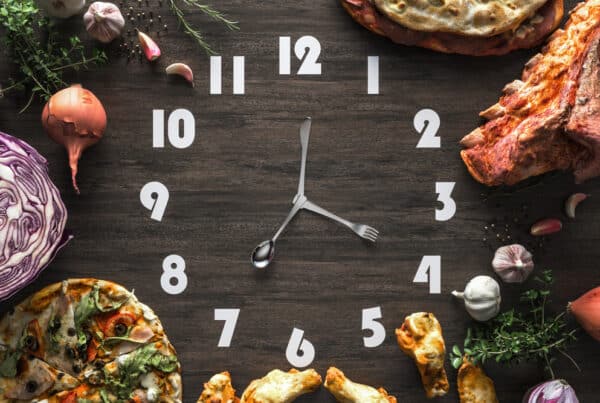Have you ever felt like your weight loss efforts have been in vain, no matter how hard you work? Welcome to the frustrating world of weight loss plateaus.
You’re not alone. It’s like running full tilt towards your goal, only to slam face-first into an invisible wall. You’re eating right, exercising often but those numbers on the scale refuse to budge.
In this post, we’ll dive deep into understanding these mysterious pauses in progress – from metabolic rate changes and set point theory role in our bodies’ resistance against losing more weight. We will also discuss ways to break through these stubborn stalls using dietary adjustments such as low-carb diets or increased protein intake.
But we don’t just call it a day there. Stuff like stress management and knowing about sleep’s importance also come into play!
Table of Contents:
- Understanding Weight Loss Plateaus
- Overcoming Weight Loss Plateaus with Dietary Adjustments
- Using Intermittent Fasting to Overcome Weight Loss Plateaus
- Importance of Hydration in Weight Loss
- FAQs in Relation to What Are Weight Loss Plateaus
Understanding Weight Loss Plateaus
Hitting a weight loss plateau is like getting stuck in traffic on your way to work. You’ve been cruising along, making good time, but then you hit a standstill and progress comes to a screeching halt. Let’s unpack what causes this frustrating phenomenon.
The Concept of Set Point Theory
The human body is an amazing machine that likes consistency – it has its own internal thermostat known as the ‘set point’. This theory suggests our bodies have an established range of weight they’re comfortable at, and when we try losing weight, our metabolic rate adjusts to resist changes.
This resistance can lead us into the murky waters of a weight loss plateau, which happens when the scale won’t budge despite your best efforts for weeks or even months. But don’t lose hope; these plateaus are common and usually last between eight to twelve weeks.
The Role of Exercise Frequency in Weight Loss Plateaus
Just like how turning up your car’s engine burns more fuel faster, increasing exercise frequency can rev up your metabolism – helping you get past that annoying plateau stage.
In fact, muscle mass plays an essential role here since muscles burn calories even while resting. So strength training could be considered one of your greatest allies against hitting another ‘traffic jam’ on your journey towards achieving healthy body composition. The secret lies not only in exercising often but also in diversifying physical activities for maximum effect.
Overcoming Weight Loss Plateaus with Dietary Adjustments
You’ve been doing everything right, from hitting the gym regularly to counting every calorie. But suddenly, your weight loss journey seems to have hit a roadblock – you’re stuck in a frustrating plateau.
No worries. This is a common occurrence for even the most devoted dieters, so don’t worry. The good news is that we can use dietary adjustments as an effective strategy for breaking through this barrier.
Low-Carb Diets for Weight Loss
One approach that has shown promising results is shifting towards a low-carb diet. According to research, consuming 50 or fewer grams of carbs per day can lead to more weight loss compared with traditional diets.
This doesn’t mean you need to completely eliminate carbs from your meals though. It’s about choosing better food options – swap refined grains with whole ones, sugary drinks with water or unsweetened beverages and always make sure fruits and vegetables fill half your plate at each mealtime.
The Role of Protein and Fiber in Weight Loss
Besides reducing carb intake, increasing protein consumption could also help break free from the stubborn plateau. A study suggests having at least 20 grams of protein at each meal may boost metabolic rate helping burn calories faster.
Foods rich in proteins include lean meats like chicken breast, fish such as salmon or tuna; dairy products like yogurt or cottage cheese; plant-based sources such as lentils beans chickpeas nuts seeds tofu tempeh etc.
And let’s not forget about fiber, the unsung hero in our weight loss journey. Consuming more high-fiber foods can make us feel fuller for longer periods, thus reducing appetite and decreasing calorie absorption as suggested by a study. Think about adding whole grains, beans, fruits and veggies to your eating routine.
Increase Exercise Frequency
Remember, it’s important to strive for equilibrium and select options that are beneficial for your well-being.
Key Takeaway:
Breaking through a weight loss plateau can be achieved with dietary adjustments. Consider shifting to a low-carb diet and increasing protein intake for more effective results. Don’t forget the power of fiber in keeping you full, reducing calorie absorption. Balance these changes with regular exercise for lasting health benefits.
Physical Activity Promotes Weight Loss
When we think of weight loss, exercise often comes to mind. Did you know that engaging in everyday activities like walking, cleaning or gardening can also help with losing weight? Non-exercise physical activity refers to the energy expended during daily activities like walking, cleaning, or gardening.
Engaging in activities that don’t require a trip to the gym, such as walking, cleaning and gardening, can help you expend more calories and reach your weight loss goals. Even if you can’t go to the fitness center, discovering methods of staying active in your daily life could still be useful for achieving weight loss objectives.
Using Intermittent Fasting to Overcome Weight Loss Plateaus
If you’re stuck in a weight loss plateau, don’t lose heart. There’s an unexpected ally that might just help you kick-start your progress again: intermittent fasting.
The Magic of Intermittent Fasting for Weight Loss Plateau
Intermittent fasting is more than just skipping meals. It’s about strategically cycling between periods of eating and not eating. You might ask why this would work when it feels like your body is stubbornly holding onto every pound? The answer lies in how our bodies evolved over millennia.
In the days before supermarkets, humans had to endure periods without food. Our bodies adapted by switching energy sources during these times – from using glucose derived from daily food intake to burning stored fat instead. And that’s where the good news comes in for those looking at overcoming their weight loss plateaus.
Fat Burning and Health Benefits of Intermittent Fasting
Your body has two main fuel sources – sugar (glucose) and fat. During an extended fast, once your liver exhausts its glucose stores, it starts breaking down stored fats into molecules called ketones for energy—hello fat burning. But besides nudging your metabolism out of its comfort zone (and possibly past a plateau), there are other health benefits linked with intermittent fasting as well.
- Better insulin sensitivity: With less frequent meal-induced insulin spikes, cells can become better at responding to insulin over time leading to lower blood sugar levels.
- Inflammation reduction: Reducing your daily caloric intake through intermittent fasting could potentially decrease inflammation and lead to better health.
So, intermittent fasting might just be the spark you need to rekindle your weight loss journey. And remember, it’s not about starving yourself but rather changing when you eat.
Key Takeaway:
Stuck in a weight loss plateau? Intermittent fasting could be your unexpected ally. It’s not just skipping meals but strategically cycling between eating and not eating periods. This method can shift your body from using glucose to burning stored fat, kick-starting weight loss again. Plus, it offers extra health perks like better insulin sensitivity and reduced inflammation.
Importance of Hydration in Weight Loss
You may have heard the expression “Water is essential,” but did you understand it could likewise be your mystery weapon for shedding pounds? Yes, that’s right. The power of hydration often goes unnoticed on a weight loss journey.
The Metabolic Boost from Water
Drinking water for weight can actually give your metabolism a quick boost. Research shows an increase in metabolic rate by up to 30% within 10 minutes of drinking water. This means that sipping more H2O throughout the day helps your body burn calories faster.
This doesn’t mean replacing all other beverages with water but making sure you’re getting enough alongside them. Not only does this keep us hydrated and help maintain bodily functions, but it aids our efforts to lose fat too.
Coffee and Tea: More than Just Caffeine Hits
We all love our morning cuppa joe or tea for its energy-boosting caffeine content. But these popular drinks bring some good news for those trying to shed pounds too. Both coffee and tea are packed with antioxidants known as catechins which can assist with burning fat.
Studies suggest green tea particularly increases fat oxidation – that’s science-speak for helping your body burn off stored fats.
Aiding Digestion & Suppressing Appetite
Besides boosting metabolism and burning fat, staying well-hydrated can also help you control your food intake. How? Water aids digestion and makes us feel full, so we’re less likely to overeat.
Ever noticed how having a glass of water before meals helps curb hunger pangs? This simple trick might be all it takes to resist that extra slice of pizza.
Fighting Off False Hunger
It’s usually our own physical selves that we’re referring to in this situation.
Key Takeaway:
Water isn’t just for thirst – it’s a secret ally in weight loss. It revs up your metabolism, aids digestion, and curbs hunger. Likewise, your daily coffee or tea does more than wake you up; they’re brimming with antioxidants that help burn fat. So when the munchies hit next time, grab a glass of H2O.
FAQs in Relation to What Are Weight Loss Plateaus
How long does a weight loss plateau last?
A typical weight loss plateau can stick around for eight to twelve weeks. But, remember everyone’s body responds differently.
What is considered a weight loss plateau?
You’ve hit a weight loss plateau if your scale hasn’t budged for several weeks despite sticking with your diet and exercise plan.
Are plateaus good in weight loss?
Sure, they can be. Plateaus show that you’re making progress but need to adjust something – maybe it’s diet or exercise habits – to keep losing pounds.
What is a 3-week weight loss plateau?
A three-week stall in dropping pounds while following the same lifestyle regimen signals an early-stage weight-loss halt. Don’t worry; small tweaks should get things moving again.
Conclusion
Weight loss plateaus can feel like invisible walls. But now you’re aware of them and why they happen.
You’ve learned about the set point theory and how it plays a part in weight gain after losing weight. You discovered that adjusting your food intake, particularly protein and fiber, can help you overcome these stalls.
You found out stress management isn’t just for mental health – it’s crucial to physical health too! The importance of sleep also shouldn’t be overlooked on this journey!
Lastly, remember that tools like intermittent fasting might give an extra push when needed.
The takeaway? Understanding “what are weight loss plateaus” is the first step towards breaking through them. Knowledge gives power over frustration on your path to healthier living!




